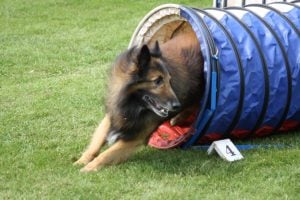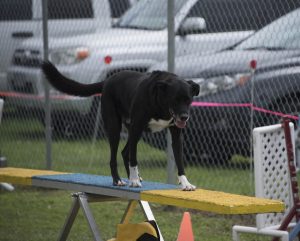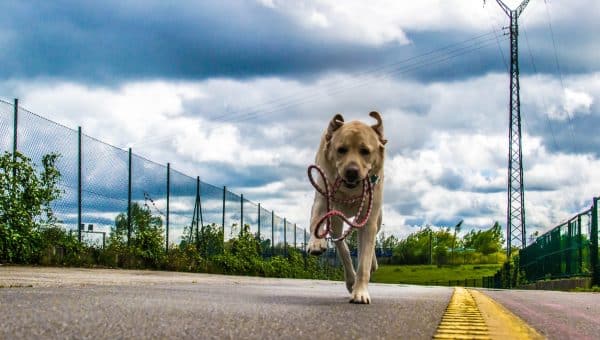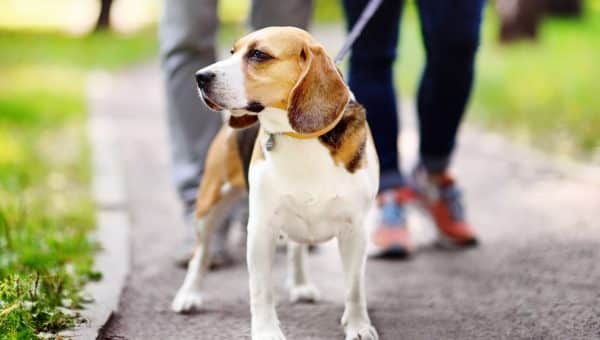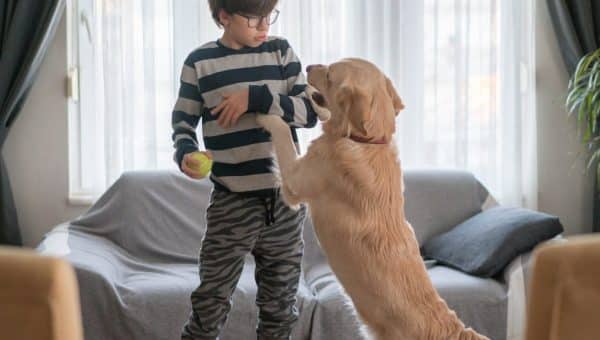Last year, an incredible agility run by a border collie named Tex became a viral video hit after he won the Masters Agility Championship at the Westminster dog show. In his record-setting performance, the sleek, agile border collie flew over jumps, zoomed through tunnels, and wove through poles like they weren’t even there.
Your dog doesn’t have to be an elite athlete like Tex to learn and benefit from agility skills. Agility training welcomes dogs of all sizes, ages, and levels. The basics are surprisingly straightforward and incredibly fun.
Read on for expert tips on how to train your dog—yes, yours!—in basic agility skills.
Jumps

via imgur
A lot of dogs will jump over obstacles out of instinct. (My pups became pro puddle-hoppers with no help from me.) The key to teaching them to clear hurdles is to let instinct be their guide.
Trainer Karen Von Hoy suggests setting up a short series of hurdles with the bars on the ground. Remember, you’re in this together, so start by walking/jumping alongside your dog through the vertical bars and over the horizontal bars. You’ll gradually raise the bar until your dog is jumping over them with ease.
If you don’t have easy access to hurdles, no big deal. You can set up your own makeshift obstacle course using broomsticks or PVC pipes.
Tire Jumps
The training process for tire jumps is similar to hurdles, but it’s more tricky, as it asks your dog to go through a narrow space. AffordableAgility.com recommends starting with the tire lowered all the way to the ground. Go slow. Then greet your dog with lots of enthusiasm when they make it through!
Important safety note: competition tire jumps are specially constructed to give or break away (i.e., they’re not real tires). Collisions with tires can cause serious injury, so trainers recommend hitting your local agility park or investing in a regulation tire jump to practice this skill safely.
Tunnels
Going through tunnels is one of the simplest agility skills, and most dogs pick it up very quickly. Why? Because the main “skill” needed is an interest in getting to a treat on the other end.
Expert trainers recommend starting with a very short tunnel, so your dog can see all the way through. Encourage them to run through it, and when they do, give them a treat. Gradually increase the length of the tunnel. See this video from PurinaProPlan for more detailed instructions.
Chutes

via flickr/26205675@N07
Agility chutes, or “closed tunnels,” require your dog to run through a space without being able to see what’s on the other end. Chute training should start after your dog is easily running through tunnels. The process is similar to tunnel training: start small, and gradually increase the length of the chute as your dog gains skill and confidence.
When training chutes (or any skill), always encourage your dog with a bright, enthusiastic voice. As the experts at AffordableAgility.com point out, “it’s dark in there and your voice will help assure him that everything will come out okay in the end.”
Pause Table
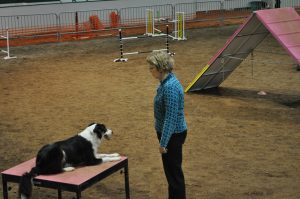
via flickr/lalouque
The pause table is a unique agility skill that asks your dog to jump on a table and hold a stay for five seconds. If your dog can already rock a solid “stay,” you’re halfway there! The next step is to take it to the table.
Start with a lower surface, and lure your dog onto it. As she gets more and more confident hopping up, you can raise the height of the table. This video from PurinaPro Plan demonstrates each step of the pause table process.
Contact Obstacles
Contact obstacles ask your dog to—you guessed it—make contact with specific parts of the obstacle. In competition, the contact zone exists for safety reasons, as it slows dogs down at the beginning and end of more treacherous obstacles. Outside of competition, teaching your dog contact skills can improve their focus, confidence, and body awareness.
There are four “contact obstacles” in standard dog agility courses:
- The dogwalk: a raised, narrow platform that dogs traverse.
- The A-frame: a steep ladder that dogs climb and descend.
- The seesaw: much like a playground seesaw that dogs walk up. They’re lowered down on the other end.
While these obstacles are more complex, the skills and training needed are straightforward. The bottom line? Work with your dog on targeting specific areas and maintaining specific positions.
This trainer video shows you how to start contact training at home without any equipment:
Weave Poles

via imgur
Watching dogs navigate weave poles is one of the most fun agility tests to see, but it’s also one of the most challenging to teach. Think about it this way. Other agility skills, like jumping and climbing, happen naturally in your dog’s everyday life. But how often do they have to weave around narrow poles in a straight line?
Thankfully, as with all agility skills, baby steps, patience, and enthusiasm make training a breeze. You can start by simply luring your dog around obstacles with a treat. But if you want to get more serious about agility training, experts recommend investing in a set of weave poles.
This guide from Way to Weave gives detailed instructions for getting your dog started. They recommend keeping training sessions short, as weaving asks your dog to use muscles they may not have used before.
So if agility training looks like fun—and it is!—why not sign up for a beginners’ class in your area? Your dog will get a great mental and physical workout. Plus, who knows? You may just have the next Tex on your hands.


